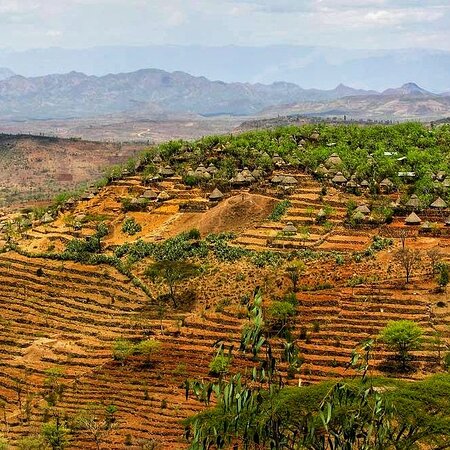Designated as a UNESCO World Heritage Site in 2011, the Konso Cultural Landscape encompasses 230 square kilometres in Ethiopia's semi-arid southern region. The area is renowned for its intricate terraced agriculture, walled hilltop villages, and rich cultural heritage. Its residents, the Konso people, have shaped the land into a productive network of flat fields through centuries-old dry-stone contour walls that conserve soil and collect rainwater. The Konso Cultural Landscape provides a glimpse into one of Africa's oldest and most distinctive traditions, blending architecture, art, and sustainable agricultural practices.
Ancient Villages and Architecture
Konso
villages, known as paleta, emphasise defensive structures. Built on
elevated hills, they are surrounded by up to six concentric basalt stone walls,
reaching heights of four meters. Access is restricted through ceremonial gates,
reflecting the importance of security in their culture.
Each village features mora or community houses—open-sided, thatched structures where elders convene, and young men sleep communally. These houses symbolise unity and tradition. Villages also display olahita (generation poles) erected every 18 years to mark new age-sets. The oldest village, Dokatu, boasts 43 generation poles, indicating its existence for over 750 years.
Agricultural Mastery
Faced with
rocky and arid terrain, the Konso people have developed an advanced terracing
system to combat erosion and sustain agriculture. Using dry-stone walls, they
create terraces that preserve soil and trap rainwater, enabling sustainable
farming.
Key crops
include sorghum, harvested twice a year, along with maize, beans,
sunflowers, and coffee. Sorghum serves as the base for local dishes like korkorfa (a
dumpling-like food) and a traditional beer. Livestock dung is used as
fertiliser, and water is sourced from harda reservoirs, circular
stone structures that store rainwater.
Artistic and Spiritual Traditions
The Konso
are celebrated for their waka grave markers—anthropomorphic statues
carved from hardwood to honour important figures, warriors, or those who faced
predators. These sculptures, often adorned with facial features and animal bone
teeth, reflect the deceased's identity and legacy. A collection of waka is
displayed at the Konso Museum near Karat-Konso.
Exploring the Region
Karat-Konso serves
as the main hub for visitors, offering accommodations and access to nearby
attractions. Highlights include:
Mecheke
Village - Known for its hilltop setting and clusters of waka grave
markers.
Dokatu
Village - Over 750 years old, bustling with activity on market days
(Monday and Thursday).
Gesergiyo
Gorge - Famous for sand pinnacles resembling skyscrapers, dubbed “New
York.”
Sacred
Kalla Forest - Home to an ancient chief’s compound and the Konso Coffee
Cooperative.
Doha Hot
Springs - Accessible by foot, ideal for hikers exploring over several
days.
Getting
There:
Karat-Konso
is 540 kilometres south of Addis Ababa, accessible via road through Butajira
and Arba Minch. Ethiopian Airlines offers daily flights to Arba Minch, 85
kilometres north of Konso.
Getting
Around:
Visitors
must register at the Konso Tourist Information Centre in Karat-Konso
to arrange guides and pay entrance fees. Multi-day treks are also available.
Accommodation
and Shopping:
Lodging
options range from a tourist lodge outside Karat-Konso to budget hotels in the
town centre. Traditional Konso fabrics and handicrafts can be purchased at
local stalls.
The Konso Cultural Landscape stands as a testament to human ingenuity, showcasing sustainable agricultural practices, unique art forms, and a deeply rooted social structure. Its terraced hills, walled villages, and waka statues provide visitors with a rich cultural and historical experience. Whether exploring ancient sites or observing traditional markets, Konso offers a rare insight into one of Africa's most fascinating communities.
A Glimpse into Konso Culture
The Konso
people have a unique and fascinating culture, deeply rooted in their history
and environment. Their distinctive architecture, intricate wood carvings, and
elaborate hairstyles are a testament to their artistic flair and ingenuity.
Konso's
Architectural Marvels: The Konso are renowned for their impressive stone-walled
villages, which are strategically built on hilltops to protect them from
enemies. These villages are a marvel of engineering, showcasing the community's
collective effort and skill.
Intricate
Wood Carvings: The Konso people are skilled woodcarvers, creating intricate
designs on their tools, furniture, and ceremonial objects. These carvings often
depict mythological figures, animals, and geometric patterns, reflecting their
deep spiritual beliefs.
Elaborate Hairstyles: The Konso people adorn themselves with elaborate hairstyles, which are often symbolic of their social status, age, and marital status. These hairstyles are a source of pride and identity for the Konso people.
A Memorable Experience
Our visit to Konso village was a truly unforgettable experience. We had the opportunity to witness firsthand the daily lives of the Konso people, their warm hospitality, and their deep connection to their land.
As we bid farewell to Konso, we carried with us a profound appreciation for the rich cultural heritage of this remarkable community. It is a place that should be cherished and preserved for generations to come. #Ethiopiatravel, #Konso, #AfricanCulture, #CulturalHeritage, #TraveltoEthiopia #tripsEthiopia
 |
konso man weaving cloth on his loom karat konso |



